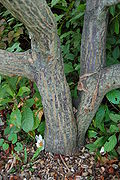Franklinia alatamaha
| Franklinia alatamaha subsp. var. | Franklin tree | |||||||||||||||||||||||||||||||||||||||||||||||||||||||
|---|---|---|---|---|---|---|---|---|---|---|---|---|---|---|---|---|---|---|---|---|---|---|---|---|---|---|---|---|---|---|---|---|---|---|---|---|---|---|---|---|---|---|---|---|---|---|---|---|---|---|---|---|---|---|---|---|

|
|
| ||||||||||||||||||||||||||||||||||||||||||||||||||||||
| ||||||||||||||||||||||||||||||||||||||||||||||||||||||||
Franklinia is a monotypic genus in the tea plant family, Theaceae. The sole species in this genus is a flowering tree, Franklinia alatamaha, commonly called the Franklin tree, and native to the Altamaha River valley in Georgia in the southeastern United States.
Franklinia alatamaha is a deciduous large shrub or small tree growing to 10 m ft tall, but commonly 4.5 - 7.5 m. It is commercially available for garden cultivation. It is prized for its fragrant white flowers, similar to camellia blossoms. Flowers appear mid-summer to early fall, and may last as the tree's leaves change color.
The tree has a symmetrical, somewhat pyramidal shape, with different individuals of the species forming almost identical crowns. It forms several vertical trunks close to ground level. The bark is gray with vertical white striations and has a ridged texture. The alternate, obovate leaves are up to 6 in cm in length and turn a bright orange-red in the fall. Although difficult to transplant, once established Franklinia can live a century or more.
Franklinia fruit develops slowly. The seed capsules require 12–14 months to mature. When ripe the 5-valved spherical capsules split above and below in a unique manner. Anecdotal evidence suggests viable seed production is enhanced where two or more plants are present in close proximity.
Cultivation
The Franklin tree has a reputation among gardeners for being difficult to cultivate, especially in urban environments. It prefers sandy, high-acid soil, and does not tolerate compacted clay soil, excessive moisture, or any disturbance to its roots. The Franklin tree has no known pests, but it is subject to a root-rot disease and does not endure drought well.[1]
Propagation
Pests and diseases
Varieties
Gallery
-
Leaves
-
Trunk bark
-
Autumn leaves
References
- ↑ U.S. Forest Service, "Franklinia Alatamaha, Franklin-Tree," Fact Sheet ST-260, November 1993.
External links
- w:Franklinia alatamaha. Some of the material on this page may be from Wikipedia, under the Creative Commons license.
- Franklinia alatamaha QR Code (Size 50, 100, 200, 500)


